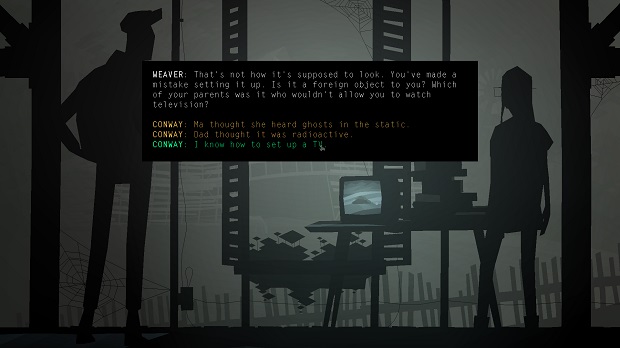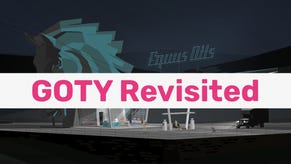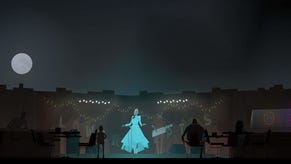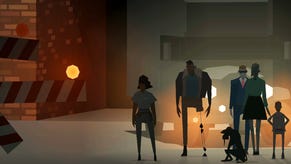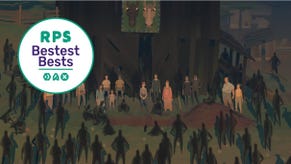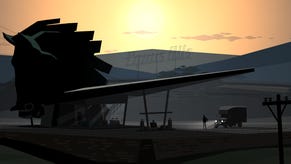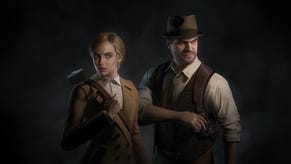What Makes Kentucky Route Zero's Dialogue So Good?
Interpreting the Echo
This is The Mechanic, where Alex Wiltshire invites developers to discuss the inner workings of their games. This time, Kentucky Route Zero [official site].
I haven’t a lot of patience for dialogue in games. Weighted by exposition and lumpen characterisation, it tends to lumber, but I love the dialogue in Kentucky Route Zero. Telling a story which balances the bizarre with the everyday, it communicates so much with so few words. And the technology that lies behind them is ancient, wielded by games pretty much since their advent. But Kentucky Route Zero employs a twist of design that makes a world of difference:
THE MECHANIC: Multiple choice
When Kentucky Route Zero presents you with a set of options for how its characters will respond to a prompt, it seems simple. They look just like those of any LucasArts classic.
But you soon realise there’s more going on, and yet with less. Unlike those of LucasArts, most conversations don’t branch and come back on themselves, so you can’t wring every last bit of drama from them by exploring every option. Instead, what’s said is said and you have to leave it behind you.
For all their simplicity, these conversations play out far more naturalistically than anything by LucasArts, or indeed BioWare, and through the subtlety of both the design and writing. That’s because the power of the design lies in the fact that the choices themselves give you insight into the interior and exterior lives on the screen. So when Conway talks to his dog about Equus Oils you know his take on the place, simply through the list of choices, regardless of which you ultimately choose.
We’re more observers than participants in Kentucky Route Zero. Its players aren’t fully under our control, and our perspective constantly shifts between them as the game requires. “Our surface level treatment of dialogue was to show it as though you are maybe watching a play from a distance, maybe too far to hear the actors speaking, so you’re reading along with the script or something like that,” its writer and programmer, Jake Elliott, tells me.
But the choices you’re given are still meaningful. Perhaps we’re also directors of this story, because I have my own Conway. He’s a gentle and uncomplicated man; he speaks as he sees, and doesn’t see very much. But he could be more insightful or more assertive if I chose other options. You know they won’t really shift the narrative but they have a knack of letting the characters breathe, and you get a greater idea of who they are, and who they could be.
This particular form of influence over the characters’ inner lives also lends Kentucky Route Zero much of its economy, where lives are suggested in just a few lines. Elliott was inspired by films like Peter Greenaway’s A Walk Through H, in which a narrator tells the story of a journey as the camera slowly pans over a series of hand-drawn maps. “It has this really engaging story about a metaphysical journey but it’s so economical. That stuff really speaks to me as an artist.” In Kentucky Route Zero, letting the player take a part in how a character reacts emotionally doesn’t require animation or voice work, just text. “I think Dark Souls also is really good at being very economical with the way it uses lore. They put some text in there that’s just hints and most of it is just happening in the minds of players and on forum threads. It’s just so effective and powerful.”
While the overall narrative won’t shift, choices can quietly change future details, giving Kentucky Route Zero a subtle dynamism. “Some lines that people speak are weird cutups of these different options, the sentences rearranged at the word level in a way that we wouldn’t be able to do if we had to record everything with actors,” says Elliott. The game retains a database of what you’ve seen and what you chose, which Elliott describes as ‘haphazard’ because it’s rather less than exhaustive. “We’ve been planning some things that we’d capture and use later, but a lot of things is just, ‘Ah, it might be interesting to know what they said about that,’ and not really know how we’d use it later.”
The effect can be poetic, though you often don’t even notice it. That’s a strength, by the way, because Kentucky Route Zero avoids that portentous sense you get in many games with narrative choices, where every action feels weighted with the threat it might lead to the “bad ending”. The effect is that you play naturally rather than self-consciously or with some plan in mind. “This is not a story about strategising, or knowing where you’re going, or having a certain goal that you can accomplish in a certain way,” says Elliott. “The characters respond to it, they’re trying to make this delivery but they don’t really seem that urgent about it. They mostly want to talk to people. I think we were thinking about telling a story about people who aren’t necessarily in the position to strategise. They are responding to their conditions, and they are people who are, in their nature, more curious than aggressive or forceful. We want the player to be in a state where they’re asking characters questions about themselves, just inquisitive and curious.”
Players can therefore get very different experiences. “All three of us really love that aspect of it,” says Elliott. To the extent that they’ve invested huge resources in things that only a proportion of players will ever see. For example, in Act II, there’s a sequence in which an organist plays some specially written music which was recorded in a church. But only if you walk out far enough on a balcony in the Bureau of Reclaimed Spaces. Yet it was major production for the three-person team. “It gives the project an interesting lop-sided shape that makes it feel really alive and strange and interesting, where the value isn’t represented by being in the main walkthrough,” says Elliott. “That’s a value in itself.”
As Kentucky Route Zero’s writer, Elliott’s challenge is keeping in his head players’ differing experiences, and the fact that so much of these experiences is simply down to suggestion. Though he can test sequences in the engine, he usually finds himself only fully playing them once they’re finally incorporated into the scene towards the end of production. “I can kind of model it in my head most of the time, or I think I can, but I can usually tell if it doesn’t flow right,” he says.
Still, his process has changed over the course of the game’s development. He started out using a more or less lightweight markup language he devised himself, so that he could quickly write and throw things out. But then he used Twine to make a playable mockup of a conversation for artist and co-programmer Tamas Kemenczy and sound designer Ben Babbit. “I was looking at Twine’s actual text code and it was way better and more terse than this language I’d evolved independently, so I just switched to working in it.” So today he writes in its native language, Twee, and has a script which exports it into the game. “It’s gotten really slim and the goal of all of that is so I can write quickly and not have to plan ahead too much.”
The pleasure of playing Kentucky Route Zero is due in part to the way its text is presented. The beautifully aliased letters (based on the font Inconsolata, font-nerds) is one aspect, but the way they spool out one at a time also reflects the fact that text here is being wielded in a realtime medium. If you’ve played Japanese visual novels like Phoenix Wright and Danganronpa, you’ll know it feels very similar, where care is taken in how text is broken up between cards, how it’s paced, briefly pausing for semi-colons, longer for full-stops, and how it might trigger sound effects or animation. In Kentucky Route Zero these are pretty sparingly used in the first three Acts, but you can expect more gestures from characters in the forthcoming Act IV.
Kentucky Route Zero is also playful with its dialogue and the choices it offers. You get to write poetry and lines of a song, and to compose a side of a phone conversation that you can’t hear. You decide your dog’s name and gender and play text-based games on computer terminals. The most inventive of these sequences is – note that spoilers lie ahead if you haven’t yet played Act III – when you use the computer Xanadu.
On this old machine, the group of characters play a version of Colossal Cave Adventure, the proto-text adventure game made for university mainframes in 1976. “It’s one of the most important works that we refer back to in Kentucky Route Zero and that scene was really going deep with it,” says Elliott. “We took the actual code for Colossal Cave Adventure and pulled out the original text so it was exactly right to start with, and then edited it and treated it as though we were doing a playthrough of that game with this weird stuff added, so it was kind of a remix.”
The choices you get are suggestions for things to type in from different characters, one of them a young boy called Ezra, who cheerfully suggest silly things to type in, the kind that you do when you were a kid playing a text adventure. For me, it evokes fond memories of one-finger typing KILL THORIN into The Hobbit on our BBC. “Climb a tree!” Ezra says. “Eat the lamp!” he says later.
“Actually, I was maybe five or six years old and my dad was a graduate student studying computer science and we had a home terminal that dialled into the university he was studying at,” Elliott says. “I would play Colossal Cave Adventure over this terminal and it was really, really hard, especially for a five or six-year-old. I couldn’t work out how to quit the game before we disconnected so we were thinking we had to figure out how to die, and I couldn’t find a hole to fall down, even though there are a lot in Colossal Cave Adventure. So he told me, ‘Why don’t you try eating the lamp?’ So I typed in EAT LAMP, and the computer responded, “Don’t be ridiculous”. I was mortified! My dad had humiliated me in front of this computer and I’ve never forgotten that early encounter with videogames, so that’s why that’s in there.”
Xanadu represents much of why Kentucky Route Zero’s dialogue works so well, balancing deft characterisation with surreal imagery, and layering a game over it which seems to suggest possibilities – some fearsome, some funny, all mysterious – that live far outside the bounds of simple branching choices. It turns out that text hasn’t lost the power to create worlds. Who knew?


